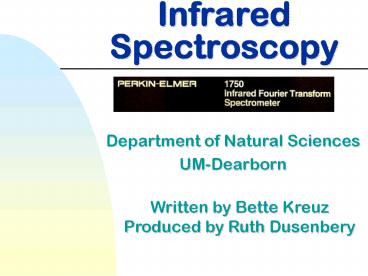Infrared Spectroscopy - PowerPoint PPT Presentation
1 / 41
Title:
Infrared Spectroscopy
Description:
Infrared Spectroscopy Department of Natural Sciences UM-Dearborn Written by Bette Kreuz Produced by Ruth Dusenbery Info Slide 17 A sample of a printout of an IR spectrum. – PowerPoint PPT presentation
Number of Views:1181
Avg rating:3.0/5.0
Title: Infrared Spectroscopy
1
Infrared Spectroscopy
- Department of Natural Sciences
- UM-Dearborn
Written by Bette Kreuz Produced by Ruth Dusenbery
2
Info Slide 1
- Infrared spectroscopy is an instrumental method
of analysis that can be used to identify and
quantify samples ranging from pharmaceuticals to
diesel emissions.
3
Slide 1 Introduction
4
Info Slide 2
- All modern instruments are Fourier Transform
instruments. - In all transmission experiments radiation from a
source is directed through the sample to a
detector.
5
Slide 2
Sample Compartment
IR Source
Detector
6
Info Slide 3
- The measurement of the type and amount of light
transmitted by the sample gives information about
the structure of the molecules comprising the
sample.
7
Slide 3
Infrared Source
Detector
Sample Compartment
8
Info Slide 4
- In the IR region of the electromagnetic spectrum,
the absorption of radiation by a sample is due to
changes in the vibrational energy states of a
molecule.
9
Slide 4
10
Info Slide 5
- The pattern of absorption as a function of
wavelength is called an IR spectrum.
11
Slide 5
12
Info Slide 6
- To obtain an IR spectrum, the sample must be
placed in a container or cell that is
transparent in the IR region of the spectrum. - Sodium chloride or salt plates are a common means
of placing the sample in the light beam of the
instrument.
13
Slide 6
IR transparent Salt Plates
14
Info Slide 7
- These plates are made of salt and must be stored
in a water free environment such as the
dessicator shown here.
15
Slide 7
Dessicator Water-free Environment for
Water-sensitive Salt Plates.
16
Info Slide 8
- The plates must also be handled with gloves to
avoid contact of the plate with moisture from
ones hands.
17
Slide 8
18
Info Slide 9
- To run an IR spectrum of a liquid sample, a drop
or two of the liquid sample is applied to a salt
plate.
19
Slide 9
20
Info Slide 10
- A second salt plate is placed on top of the first
one such that the liquid forms a thin film
sandwiched between the two plates.
21
Slide 10
22
Info Slide 11
- The two plates are then secured in a sample
holder that is compatible with the particular
instrument being used.
23
Slide 11
24
Info Slide 12
- The cell holder is then placed in the beam of the
instrument.
25
Slide 12
26
Info Slide 13
- The light beam traverses the sample compartment,
as illustrated by the red line.
27
Slide 13
Light Path (shown by red line)
28
Info Side 14
- The sample is then scanned by the instrument
utilizing predesignated parameters. - A relevant background scan should already have
been taken.
29
Slide 14
Click Here to Start Scan
30
Info Slide 15
- A satisfactory spectrum has well defined
peaks-but not so intense as to cause flattening
on the bottom of the peaks. - Major peaks can be labeled
- using the peak function of the software
31
Slide 15
Well-defined peaks are labeled with the
Wavenumbers of the Absorption Maxima.
32
Info Slide 16
- The spectrum can then be printed using the print
function of the software.
33
Slide 16
34
Info Slide 17
- A sample of a printout of an IR spectrum.
35
Slide 17
Sample of a printout of an IR spectrum.
36
Info Slide 18
- The salt plates are cleaned by rinsing into a
waste container with a suitable organic
solvent-commonly cyclohexane. - NEVER WATER!
37
Slide 18
CYCLOHEXANE Solvent
38
Info Slide 19
- Cloudy plates must be polished to return them to
a transparent condition. - To polish cloudy windows, rotate salt plate on
polishing cloth.
39
Slide 19
40
Info Slide 20
- The clean plates and cell holder are stored in
the moisture free atmosphere of a dessicator.
41
Slide 20































